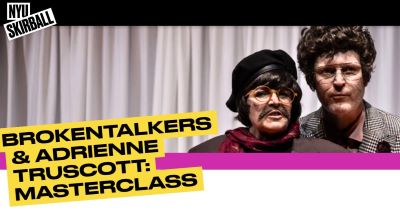WHITEOUT
NYU Skirball adheres closely to James Baldwin’s dictum: “Artists are here to disturb the peace.” With the U.S. premiere of Masterclass, Skirball’s mission has been resoundingly fulfilled. Presented by Brokentalkers & Adrienne Truscott, this provocative, 60-minute two-hander, written by Feidlim Cannon, Gary Keegan, and Truscott, is performed by two of its authors—Cannon and Truscott—presumably self-directed, as no director is credited.
The first half unfolds as a non-realistic talk show, where an exuberant moderator interviews a legendary playwright known for boundary-pushing works, such as the controversial play, Fat Cunt. Cannon, donning a Harpo Marx wig, plays the fawning interviewer, while Truscott transforms into the toxic male playwright with a padded torso, dark wig, and press-on mustache. The format echoes Inside the Actors Studio, the long-running Ovation series that featured deep dives into celebrities’ craft. However, tonight’s masterclass is a satire of that format, instead delivering outdated, crass misogyny that elicited audible groans from the audience.
The stylized, over-the-top acting provides moments of humor, both in performance and writing, but as the initial conceit stretches on, it begins to feel like a one-note sketch. Just as fatigue threatens to set in, the performance takes a dramatic and unexpected turn. Without warning, Truscott drops the pretense of her character and begins speaking to Cannon directly, recalling the moment they first met in a bar and agreed to create this very show. The shift is abrupt, leaving Cannon visibly unsettled. What follows appears to be an unscripted confrontation—whereby Truscott forces her co-performer to publicly reckon with his own privilege and sexism. Her argument builds toward a radical demand: that Cannon, as a white male artist, step aside to make room for voices that have historically been stifled.
This moment proves polarizing. Some in the audience applaud her sharp critique and her assertion that those with privilege must cede space. Others—myself included—find the approach heavy-handed, as she ultimately presumes to speak “for everyone” in her call for him to step aside, move on, and, in essence, disappear. The piece engages directly with the tensions surrounding cancel culture, artistic responsibility, and power dynamics in the arts, but whether it does so effectively or reductively is open to debate.
No wonder I briefly wished I was seeing a revival of Terrence McNally’s 1995 play, Master Class—the same title in which McNally dares to misappropriate the voice of Maria Callas. The gall! Yet, his Tony Award for Best Play has not yet been revoked or canceled because he did what is ultimately expected—at least by Truscott’s demands of Fiedlim—that every white male artist make space for new voices. Well, McNally did just that in the most inevitable way possible—by passing on. Dying. Gone.
The production’s design elements enhance its layered themes. Set designer Ellen Kirk creates a realistic talk-show environment, backed by a white curtain that lighting designer Dara Hoban washes in shifting colors, transitioning the play in and out of realism. Movement direction by Eddie Kay introduces playful minimalist choreography, though Truscott abruptly cuts it short, seemingly prioritizing polemic over performance.
One of the play’s most compelling moments comes after the curtain call. Cannon refuses to leave the stage. Truscott, after objecting, refuses as well. The house lights rise, signaling the show’s end, yet neither performer budges. The audience hesitates—unsure whether to exit or wait for resolution. Even the stage manager enters to strike props and costume pieces. Still, the stubborn performers remain. Meanwhile, over half the audience stays put, watching the silent standoff. The immoveable confrontation, while humorous, is also deeply symbolic: is this a protest against the forced erasure of certain artists, or a stubborn refusal to acknowledge necessary change?
For me, Cannon’s resistance is the more compelling stance. The idea that white male artists must be erased to make room for others is a false dichotomy; the real challenge is creating a landscape where all voices can coexist. The solution is not to cancel, but to expand—more bookshelves, more publishing, more producers willing to embrace a wider range of perspectives. The future of the arts does not demand the exclusion of one voice for another to thrive; rather, it requires a genuine commitment to inclusion without erasure.
photos by Ste Murray
Masterclass
NYU Skirball, 566 LaGuardia Place at Washington Square
ends on March 29, 2025 at 7:30
60 minutes
for tickets ($50), call 212.998.4941 or visit NYU Skirball






